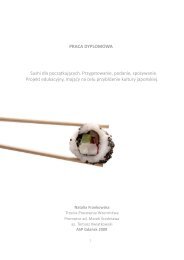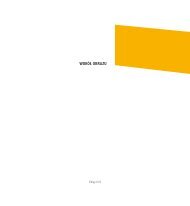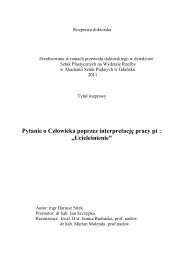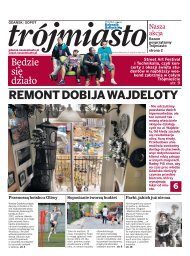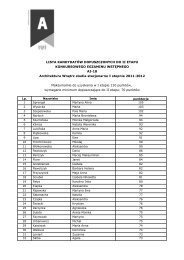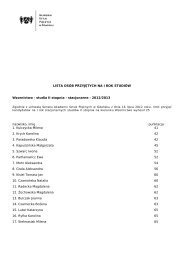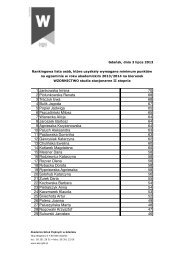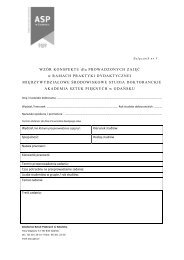P o czet dziek anó w - Akademia Sztuk Pięknych w Gdańsku
P o czet dziek anó w - Akademia Sztuk Pięknych w Gdańsku
P o czet dziek anó w - Akademia Sztuk Pięknych w Gdańsku
You also want an ePaper? Increase the reach of your titles
YUMPU automatically turns print PDFs into web optimized ePapers that Google loves.
E L Ż B I E T A K A L<br />
realism, the changes connected with the reform of education, announced and motivated<br />
through the exhibition of artistic schools of Poznań in autumn 1949 were to come.<br />
The impact of the exhibition was easy to predict: the existing “formalistic” methods of teaching<br />
needed to be adjusted to the official tenet according to which the artistic creation<br />
was a part of a propaganda system. Janusz Bogucki, who repeatedly condemned the<br />
methods of the postimpressionistic school, and called colorist-professors “workshopers”,<br />
wrote in one of his articles:<br />
I can see no artistic justification for the persistent construction of odalisques and sad puppets<br />
in colorful scarves, living among bottles, drapery and guitars to be further supported<br />
in artistic academies against the theory and the form of the true phenomena, of which<br />
the real world is full today.<br />
The reform was meant to transform the “formalistic” methods of teaching applied by<br />
“theoreticians of kapism”; the number of hours of drawing that aimed at the preparation<br />
to create the most desirable polyfigure composition with suitable ideological contents<br />
was increased, among others; and system of the studios managed by the masters was<br />
abolished, replaced by the division according to the year of studies. One of the aims of<br />
the reform was also the limitation of “pure” disciplines of creation and the expansion of<br />
the “applied” disciplines which were viewed as more useful in a socialist state. Thereof<br />
resulted the idea of limiting the teaching of painting and sculpture to only two centers,<br />
namely the academies of Kraków and Warszawa. The remaining academies were to deal<br />
with the specializations that could be used by the industry: in Łódź - fabric, in Poznań<br />
- furniture making, in Wrocław - ceramics. The limitation of the realization of this idea at<br />
the State College of Fine Arts in Sopot “only” to the termination of the Department of<br />
Sculpture, and thus the rescue of the painter’s education was attributed to the providence<br />
of foreseeing educators by Stanisław Teisseyre, who had just taken up a position of the<br />
Rector for many following years.<br />
In this critical moment - related Teisseryre years later – the exhibition called “The Youth<br />
Fight for Peace” was announced. The reform was held in the 1950s, in autumn. In the beginning<br />
of the 1950s, when the exhibition was announced, the students did not show any<br />
desire to prepare for it. Marian Wnuk and me, we knew instantly that socrealism was to be<br />
introduced, that if we wanted to defend sculpture and painting in Gdańsk region, we had<br />
to persuade the students to take part in this exhibition. We explained this to them in the<br />
Sopot Grand Hotel over vodka. We said that there was no need to change thoroughly. We<br />
should try to combine the pictorial and sculptural values with the thematic approach. […]<br />
And suddenly during this exhibition our students took most of the prizes - and now this<br />
Mangelowa, who makes the reform, and Sokorski: how could we close the painting and<br />
sculpture at this Academy of Sopot, when they took most of the prizes? And they left it to<br />
us, they made an exception and they left it. This compromise formula saved our Academy<br />
were the reason for painting to be the most important area of its activity. Already in<br />
the 1940s, when there were only two departments, of painting and of architecture, the<br />
first one was more prominent, which showed, among others, in the number of studios<br />
– including fresco technique - managed by experienced masters, who were recognized<br />
by the media and rewarded for their extramural activities (local, national, and sometimes<br />
international exhibitions). It also showed in the non-painting undertakings of the creators<br />
of the Academy connected with the painful process of the post-war reconstruction, and<br />
also with the politics that started to be more and more oppressive at that time.<br />
Gradually painting started to function also in a mythical dimension, to which it had been<br />
transferred by the remembrance of the concurrent artistic strategy of pupils and continuers,<br />
together with their convictions regarding superiority and modernity of the colourist<br />
conception of painting, with its main task of creating a colourful construction based<br />
on the study of nature; together with their care about workshop perfection and their<br />
reluctance towards extreme solutions, as well as to the words bringing an extra-artistic<br />
context into the art of painting.<br />
Graphic arts were shifted to the interior position by the so understood assignments of education<br />
and, what is even more important – together with some different subjects taught<br />
within the frames of the Department of Painting, namely ceramic arts and artistic fabric<br />
- it was regulated by the same esthetical categories and references to the discussion<br />
about art with it’s idea of autonomy, the impassable rights of painting, the superiorities<br />
of “pictorial value”, etc.<br />
The character of the Academy and its unique position within the Gdańsk region – as observed<br />
by Elżbieta Zakrzewska - were visible even in the early period of its activity. The<br />
studios of painting, drawing and sculpture were most important and they were the basis<br />
of the education process. Other workshops were being created as a result of the development,<br />
as well as the adaptation to practical assignments of the disciplines of architectural<br />
painting and applied graphic arts. Even the weaving department at the State College of<br />
Fine Arts came as a form of monumental painting.<br />
The author also states, referring to the characteristic remark of Józefa Wnukowa (“I was<br />
never interested in weaving alone. I treat fabrics as decorative painting”) who said that<br />
“paining is probably one of the basic features of many Sopot fabrics”.<br />
The Department of Paintings and Graphic Arts underwent numerous transformations in<br />
the sixty-year-old history of the Academy of Fine Arts in Gdańsk. And although numerous<br />
fusions and divisions were being executed, the structural domination of painting<br />
remained to be observed. Initially, painting was a part of the Department of Painting<br />
and Architecture, but after the transformation of the latter into a separate Department<br />
of Interior Architecture, painting formed another department together with decorative<br />
designing, under the management of Juliusz Studnicki. Soon, at the threshold of socialist



